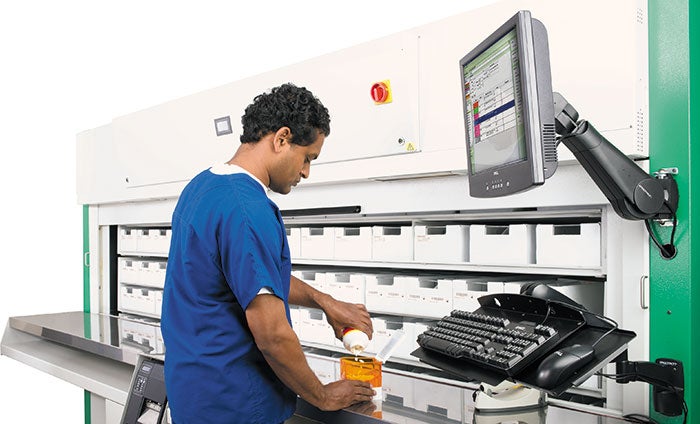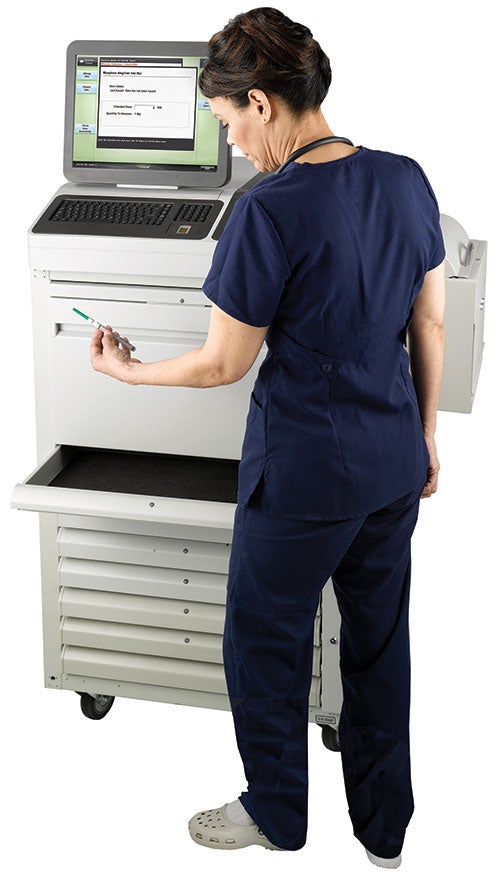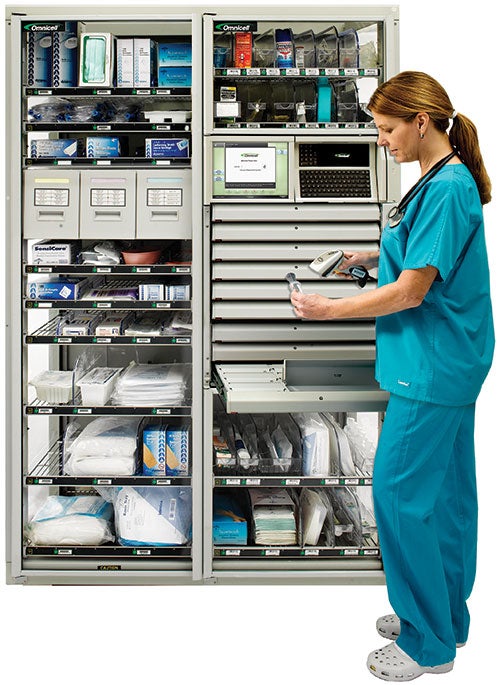Five pharmacy automation trends

This management system provides real-time inventory data, tracks usage and optimizes inventory levels.
In the era of value-based purchasing and HCAHPS, the fundamental issue that hospitals face is how to stretch their resources to improve outcomes and the patient experience while containing and ultimately reducing costs.
Pharmacy automation is helping hospitals to improve patient outcomes and reduce expenses for the hospital over the long term.
By bringing automation into the hospital environment, the pharmacy staff are unleashed from the task of counting pills in the hospital basement, and their professional expertise can be repurposed so they can contribute to clinical and service-oriented operations.
Smart technologies
Technology changes in pharmacy automation are rapidly transforming the functions of pharmacy from the old-style, cart-fill operation and dispensing drugs from the pharmacy to a new, highly efficient model. As hospitals adopt the following smart technologies, they are saving time and space, and increasing their functionality and revenue stream.
1. Flexible configurations in a smaller footprint. Because few hospitals are new enough for their floors to be designed to accommodate pharmacy automation, new dispensing cabinets now are being designed around existing hospital floor plans for efficient use of space. As automation vendors have become more flexible with their designs, it is easier for hospitals to be more creative when locating automation cabinet placement.
The biggest change in pharmacy automation in the past 10 years is that drug-dispensing cabinets have become more efficient and customizable, with high- capacity drawers that can be combined in a wide array of configurations to accommodate a facility’s unique needs. This flexibility has resulted in a dramatically reduced automation footprint on the hospital floors and expanded the ability of running multiple technologies through a single cabinet.

Medication drawer designs help to maximize pharmaceutical availability near the point of administration.
Historically, drug-dispensing cabinets were large, often taking up entire medicine rooms. A main cabinet served as the brain of the operation, measuring approximately four square feet. From the main cabinet, communication lines would run to a separate refrigeration unit with a lock on it, and then lines would run to a separate tower to get all aspects that were needed by the facility for a dispensing cabinet system. The large size of the older automation systems also constrained the nursing retrieval turnaround time.
Today’s dispensing cabinets can be found with a single, smaller tower with interchangeable, modular drawers within the tower and can be placed on the floor and still provide all of the technology that previously was provided by the older system, but in a much smaller space. This smaller footprint increases flexibility in terms of how and where automated cabinets can be positioned on hospital floors.
A small floor plan of a nursing unit can now fit one small-footprint cabinet that features a refrigerator, a tower and narcotic dispenser while providing premium service to that nursing unit. This modular design of the drawers within the cabinet allows the health facility to configure the system to meet its specific clinical and operational needs, all within a third of the space taken up by the older units.
Flexible configurations allow patient treatment areas to customize the dispensing cabinets without the cost of additional equipment and floor space. The reduced footprint impact can reduce or remove the need to build out dedicated medication rooms, saving significant expense.
2. Smarter drawers. When a nurse goes to a typical automation cabinet to remove a medication, all 25 to 50 pockets are open, giving the nurse access to multiple medications. This is known as an open-matrix configuration. In new cabinet designs, all of the pockets are locked when the main drawer is opened and the nurse only has access to the pocket for the needed patient medication. This system increases medication security, safety and simplifies charge capture issues. Even if the existing hardware frame is dated, the drawers can be retrofitted to the smarter design with lockable pockets inside main drawers.
Also in this article |
| The business case for pharmacy automation |
|
|
These smarter drawers also provide a better method for managing a patient’s home medications, which historically has been a challenge for pharmacies. The new technology allows the cabinet to contain large, lockable boxes that fit in the cabinet drawers, which store all of the patient’s home medications. Nursing has access to the patient’s home medications through a secure channel without having to access multiple, separate cabinets. This technology decentralizes pharmacy operations, pushing more functions out to the cabinets.
Medication drawer design modifications help to maximize pharmaceutical availability near the point of administration, reducing staff time and hours of chasing down medications. In addition, the need for cart-fill dispensing processes within the pharmacy department is eliminated, which also reduces employee staff time and expense.
3. Virtual control. Until recently, console boxes were the standard used by the pharmacy automation industry. They required a separate computer with separate keyboard to drive the automation cabinets on the floors. The separate console boxes were bulky and took up valuable space on the floors, and the old console was not able to communicate outside the confines of the automation system. When reports were generated, they had to be printed and scanned so they could be sent by email or delivered to the floor or pharmacy by hand. The system could only be accessed from remote locations, such as the nursing unit, via telephone to the pharmacy in the basement.
New dispensing technology has replaced the old dedicated console boxes with smarter technology management tools. The latest cabinets are controlled by virtual consoles, providing access to the system from any computer as long as it is connected to the internet. By allowing any computer to function as a console, pharmacists can log onto the system with a laptop from any location and meet the needs of nursing unit staff. New virtual consoles allow for instantaneous changes to the automated cabinet, saving time and improving efficiency.

Improved customization of inventory cabinets makes it possible to place larger and more diverse products on the floor in a safe and secure fashion.
And, because the system sends its communications through a virtual internet protocol-based system, reports can be generated and sent directly to nurse managers through email. This is a huge improvement over the old style of communication and saves a great deal of physical space that once was taken up by the old console boxes.
The old system also tied up hospital information technology (IT) server space. The new technology, using virtual console control through an internet-connected personal computer (PC), now ties into the servers at the pharmacy automation wholesaler's location. Hospital IT departments no longer need an entire rack to run servers on, saving a tremendous amount of physical space and IT hours.
Making changes to the system and testing them also is much easier using virtual control via PC access. Making changes to the system that once took as much as a month to finalize can now be done in an hour. Pharmacists and nurse managers can tap into the system’s test environment from a PC to test a change without altering the information in the system. The change can be tested to see if it works and, if so, can go live instantly. There is no longer a need to call an engineer from the automation company to run the test to see if the change works.
Dispensing-cabinet consoles are bulky and require operation from within the pharmacy. Virtual consoles allow control from network-based computers that permit pharmacy automation team members more visibility in patient care areas. Pharmacists are unchained from needing to be in the pharmacy all day. Now their time and expertise can be redirected to the hospital floor to provide direct patient care and support to the medical staff.
You may also like |
| Hospital pharmacy design compliance |
| Guide to managing pharmaceutical waste |
|
|
Patients benefit from a better understanding of their medications — when to take them and how much to take. Understanding their medications and their medication schedule is helping to reduce hospital readmissions and the cost of those readmissions.
Placing pharmacists on the floor also has been shown to reduce the patient length of stay, which provides another cost reduction for the hospital.
4. Better inventory management. Instead of inventory being a pharmacy-dispensing function, new technology with improved customization makes it possible to place larger and more diverse products on the floor in a safe and secure fashion. Historically, automated cabinets allowed for 90 percent of pharmacy inventory to be stored in a cabinet at best. Nurses often did not have access to 10 percent or more of needed drugs and supplies.
The new technology increases this benchmark to greater than 95 to 99.9 percent of pharmacy inventory available on the floor in front of the nurse at all times. In the old seven-day, cart-fill style, dispensing cabinets would run out of inventory by Day 5 or 6 of the cycle. The old issue of medications running out or not being available on time is no longer a problem because inventory reporting and restocking also are automated.
Reporting functions are much more robust over the old limitations of simply having a min-max and stock-out report. Adjustments on par levels and timing of refills can be made quickly. The modular aspect of the pockets allows for pocket sizes to be increased or decreased to accommodate greater or fewer medications so inventory needs can be managed better. This smart inventory process means inventory numbers can be kept down and not overloaded because restocking is much more accurate and follows a just-in-time model.
The refill process also is dramatically improved with smart technology. The cabinets are now capable of sending a report to the pharmaceutical wholesaler, reporting that, for example, the cabinet is short on these five drugs and designating the amount needed for each drug. The order comes to the hospital the next morning already sorted exactly for the cabinet, making the refill process efficient. This is especially useful for a large hospital building with 50 to 100 automated cabinets. As the totes come in from the pharmaceutical wholesaler, it is easy to check in the inventory, place it on a cart and refill the cabinets immediately.
Automation also decreases the risk of medication errors, and the newer medication drawer designs provide additional security for costly or controlled medications. Pharmacy inventory managers can place expensive medications confidently in automated cabinets. The added security and control significantly reduces diversion and the cost associated with diverted drugs.
5. Charge-capture accuracy. Historically, charge capture has been rife with inaccuracy. In the old charge-on-removal system, when a nurse removed a drug, the system would charge the patient for the drug that the nurse selected at that moment. A nurse might see several different pockets when opening a cabinet drawer, and if the nurse selects one drug but also decides to remove three other drugs from that pocket that the patient is taking, those additional three other drugs may not get charged to the patient. Adding a bar code to the drug packaging and a bar code scanner to the cabinet has increased charge-capture accuracy. And, because only the one drawer is available to the nurse, the nurse simply selects the drawer, removes the drug, scans the bar code on the drug and charge capture is complete.
New charge-capture technology is especially vital in the operating room (OR). Anesthesiologists are focused on the patient and not always on the charging. New technology provides virtual drawer screens that are changing the way anesthesiologists perform charge capture in the OR. When the anesthesiologist opens a drawer in a cabinet, an electronic image of the drawer pops up on the screen. The anesthesiologist selects the appropriate boxes and the system automatically charges the patient for the medication. Because medications are now tagged with bar codes, the anesthesiologist simply opens the drawer, selects the drug, scans the bar code and moves on. Accounting departments no longer have to run down missed charges and increases in revenue coming back to the pharmacy are being realized.
By integrating innovative computer technologies, such as bar code scanners and touchscreens, automated cabinets offer improved charge capture during medication removal while increasing speed of removal. This allows billing to be captured more accurately and in real time versus a paper billing model. This aspect of automation has helped institutions to increase their revenue stream because full charges are captured accurately.
Transforming operations
These top five trends in pharmacy automation are transforming the way hospitals and their pharmacies operate. Although there is an up-front expense to the hardware, the value-add is huge with the benefits of increased flexibility in a smaller footprint, greater efficiency throughout the hospital system, cost savings from pharmacy staff focused on patient care, better management of medications and increased revenue due to automatic charge capture.
Kevin Milliorn, Pharm.D., is a senior regional vice president of operations in the central region for Comprehensive Pharmacy Services, Brooklyn Park, Minn. He can be reached at Kevin.Milliorn@CPSPharm.com.




